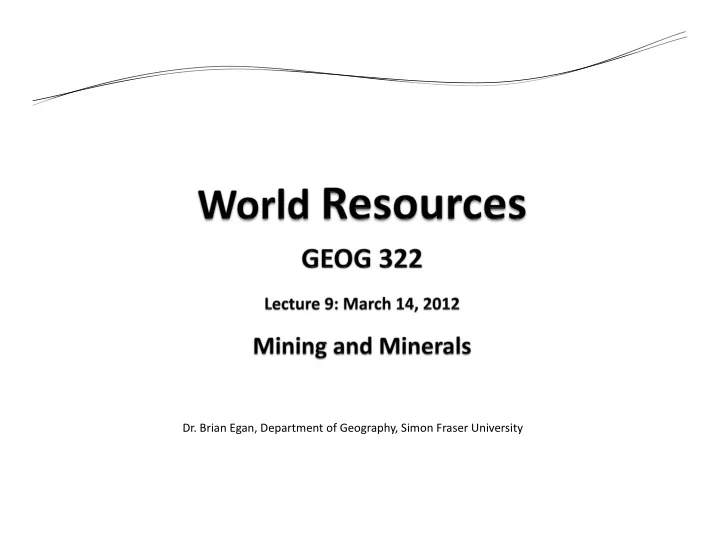

Dr. Brian Egan, Department of Geography, Simon Fraser University
revision guidelines work on improving your wri?ng. sloppy mistakes – e.g., spelling, incomplete sentences. sentence structure. flow. make full and best use of the space available. avoid empty and repe??ve text. use graphics appropriately and effec?vely. don’t use graphics to just fill space; they must add to (not repeat) informa?on in the text. make sure graphics are labeled, legible, and easy to understand. make your own graphics, if necessary. reference graphics in text.
revision guidelines (cont’d) Chicago Manual of Style; use author‐date style. in‐text cita?ons: In 2001, 40% of global peanut produc?on went into the manufacture of peanut buVer (Brown 2002). Green and Blue (2004) report that peanut buVer consump?on in China increased by 200% between 2000 and 2005. White (2006, 22) argues that China’s state owned peanut buVer corpora?on, Sino‐Peanut Corp., has come to “dominate the global market, threatening peanut buVer supplies in countries like Canada and the United States.” references Brown, B. 2002. The Global Peanut Industry . New York: Penguin. Green, A., and C. Blue. 2004. “The Chinese Peanut BuVer Boom.” Journal of Advanced Peanut Bu9er Studies 54: 22‐45. White, B. 2006. “The Looming Peanut BuVer Crisis.” Bob White’s Peanut Bu9er Blog , March 10. hVp://www.peanut‐buVer‐news.wordpress.com/2006/03/10/PB‐crisis.html
final exam Monday, April 16, 19:00 to 22:00, AQ 3154. worth 35% of your final course mark. exam format: series of short answer ques?ons (25%). three long answer (short essay) ques?ons (75%). in week 12 (first week of April) I will give you 5 essay ques?ons, three of which will appear on the final exam.
mining and minerals minerals = any naturally occurring inorganic substance. mineral resource = a mineral that has human use or value. mineral reserves = proven supply or deposits of a mineral. minerals are stock or non‐renewable resources. minerals have been key resources in long trajectory of human history; e.g., bronze age (smel?ng of copper and ?n), iron age. most mineral resources are distributed unevenly across space; aluminum and iron ores most abundant and widespread, while minerals like silver, gold, and coltan are much more rare. most minerals are not found naturally in pure form (gold and silver are notable excep?ons) but in mineral compounds or “ores”.
mineral explora?on mining companies scour the globe for highest grade ores (concentra?on of mineral element) to make exploita?on feasible and profitable. minimum economic ore grade varies with economic condi?ons, mineral price, and rela?ve scarcity of the mineral in ques?on. as mineral scarcity, demand, and price increases, lower grade ores become economically feasible and aVrac?ve (e.g. price of gold and mining in the Yukon) historically, explora?on has focused in Global North (especially USA, Canada, Australia) but the last few decades has seen great increase in mining in Global South (La?n America, Africa, Asia). this trend driven by overall trend to economic globaliza?on and key role of transna?onal capital (mul?na?onal mining corpora?ons). we are currently in a period of unparalleled growth of the mining sector spread across the globe, driven in considerable part by demand from Asia (especially China).
mineral ‘development’ a number of factors determine whether or not a par?cular mineral ore deposit will be ‘developed’ (or exploited). geological and geographic: quality, quan?ty, and accessibility of the ore. economic: supply, demand, and price for the mineral, and costs of produc?on (e.g., labour, infrastructure, royalty regime, environmental costs, etc.). poli?cal: laws, policies, royalty regimes, and considera?on of ‘strategic’ resources (e.g., potash in Canada, uranium). mining opera?ons are defined as either surface (open pit, quarrying, strip) or underground (shak, borehole) systems. the last 50 years has seen a shik to surface mining opera?ons, which are generally seen as less expensive (and less labour intensive) methods of extrac?ng mineral ores.
costs and benefits in many countries, mining is a key economic driver, par?cularly early in a na?on’s process of economic development. direct employment and income to ci?zens, and royal?es to the state (which can provide for health, educa?on, and other social programs) – but also can spur secondary industries. California case study: gold, silver, copper, and (later) oil, ?mber, and fisheries “provided spectacular bursts of wealth that propelled California along the fast track of capitalist development” (Walker 2001, 172). in California, wealth from exploita?on of natural resources was reinvested in the broader economy (manufacturing, processing, real estate) and provided basis for a more diversified economy. other case studies of economies built primarily on mineral wealth are South Africa (gold) and Chile (copper). Walker, R. 2001. California’s golden road to riches: natural resources and regional capitalism, 1848‐1940. Annals of the Associa?on of American Geographers 91(1): 167‐199.
resources and development the fact that mining is increasingly capital intensive and the lack of local processing and manufacturing of ores means that local economic benefits are oken less than hoped for. mining does not automa?cally result in ‘development’. the ‘resource curse’ (or the ‘paradox of plenty’) speaks to the fact that many countries blessed with an abundance of natural resources fare less well than countries with a poor stock of resources. why? resource conflicts. corrup?on and inequality. plunder and run. failure to reinvest natural wealth. lack of diversifica?on (the ‘staples trap’).
costs and benefits (cont’d) the high impact of surface mining opera?ons has triggered many concerns and conflicts – esp. re. impacts on environment and on aboriginal rights. water pollu?on a major concern, through runoff and leaching into streams, lakes, oceans, and groundwater. heavy metals like copper, lead, mercury, and zinc are toxic, as are chemicals used to process ores (acids, cyanide, petrochemicals) – with consequent impacts on drinking water and aqua?c life. one recent report suggested that, around the world, mining companies dump 180 million tons of hazardous waste into water bodies every year (Earthworks and Mining Watch Canada 2012). land and habitat degrada?on, impacts on plant and animals communi?es, including game species of importance to local aboriginal and non‐ aboriginal communi?es. Earthworks and Mining Watch Canada. 2012. Troubled waters: how mine waste dumping is poisoning our oceans, rivers, and lakes . hVp://www.miningwatch.ca/
Recommend
More recommend